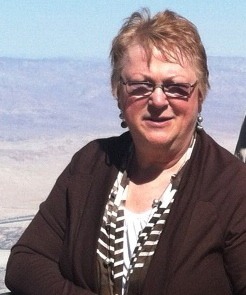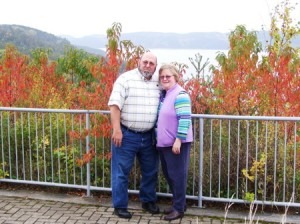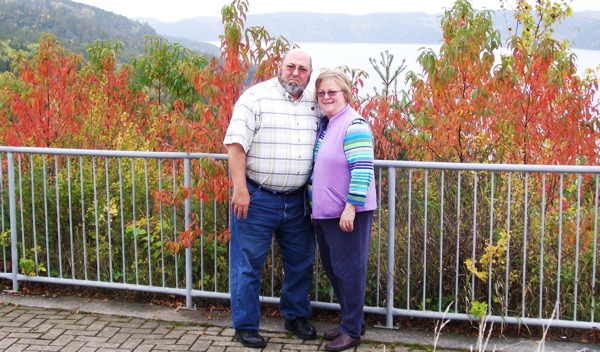May is National Foster Care Month, a time to remember the thousands of children and youth in the United States who are without “forever” families. Statistically speaking, however, the news about foster care is not all bad — the number of children in foster care in the United States and Puerto Rico has decreased since 2002. According to the U.S. Children’s Bureau, there were 408,000 children in foster care as of Sept. 30, 2010, as compared to 523,000 children in care in 2002. (This video segment from NBC4 in Columbus, Ohio, briefly touches on the life of one of those 408,000 children.)
Broomfield (Colo.) Health and Human Services celebrates its foster and adoptive families program at The Bay Aquatic Park during the summer of 2010. (Courtesy of KCCB Channel 8.) |
The Children’s Bureau’s state-by-state statistics for Colorado estimate that in 2010 there were 1,246 children in public foster care who were waiting to be adopted. The following question-and-response interview with Lucinda Wayland Connelly, program planning administrator for the Family & Children’s Services division of the Broomfield (Colo.) Health & Human Services (HHS) Department, and Sherry Bethurum, the department’s foster care coordinator, highlights the ongoing challenges and rewards of overseeing foster care at the local level.
Question: Talk to me about the kinds of situations that bring you into contact with the kids you work with.
Response: (Connelly) “The majority of the kids come into care because their parents have some issues they need to deal with. One hundred percent of the time our goal is to return the kids to their parents, and if that’s not possible, our second choice would be to place them with a relative. The majority of kids go to a home, they do not ‘languish in the system,’ and they end up going home in the long run. The majority of kids [in the system] aren’t physically abused when they come into our care, the most prevalent reason for opening a case is because parents are struggling with neglect due to mental health or substance abuse issues. We know families aren’t perfect and it’s not our goal to make families perfect.”

(Bethurum) “That said, my job is to teach foster parents about the issues that bring kids into foster care. All of our foster parents meet the [biological] parents for the kids they are caring for…Sometimes it grows into a mentor relationship. Our county philosophy is to nurture that relationship as much as possible…It’s a powerful thing when a foster parent can meet a birth parent. It’s ‘I can see you are a normal and caring person,’ and it happens both ways with people who may have never met each other any other way. By allowing parents and foster caregivers to meet, it de-vilifies everyone and ensures that everyone is working in the best interest of the child.”
Question: Tell me about the foster families you work with.
Response: (Bethurum) “The media has promulgated the idea that foster parents are in it for the money and probably more than anything, that is one of my pet peeves. Nobody’s [USDA-determined, state-administered] reimbursement is enough to cover the costs let alone make a profit. It can vary on different cases and from county to county, but it’s never more than what it costs to raise a child. Often it’s not even close to that…If you compare foster parent per diems, they’re more than often less than it costs to kennel a dog for a day, frequently. Which is sad when you think about what it says about our society. That’s what we think about our kids.”
(Connelly) “Historically, it was illegal to beat a horse before it was illegal to beat your child.
“Foster parents are just ordinary community members. They are people that may or may not have been a parent. They might wish to grow their family through ‘fost-adopt’ [fostering-to-adopt] but they may not. More than 50 percent of kids that are adopted out of foster care are adopted by their foster parents and most of those parents never intended to adopt originally. But the parents say ‘Why couldn’t we?’…It’s a beautiful thing when that happens, but we certainly never have that as an expectation going in. Other families accept that they can’t provide that, so they provide the transition [for more permanent family arrangements].”
(Bethurum) “It’s a big job, but you grow into it, just like you grow into other jobs. Parents start out not knowing much about the system, but they learn as they go.”
(Connelly) “They learn case by case. I think our foster parents become wiser with the number of cases they have. It’s never what they expect, good or bad. It would be ideal if we could have our foster families commit to three years, but there are ethics involved where we can’t require longevity. Over half of our families are kin, and they are only licensed for a specific child, but some kin are able to stay on and re-certify as a foster parent instead of a kin parent once the case has been resolved.”
(Bethurum) “I think the foster care logo would have to be ‘The hardest job you’ll ever love,’ but we’d have to steal it from the Peace Corps. You learn a lot about yourself when you think you’re going to learn a lot about kids. You learn to stretch yourself past where you thought you could. Growth comes in a gradual way. I guess I would equate it to my daughter who is a nurse. She was interviewed by one of the ‘everyday hero’ kind of programs and said at first, ‘I couldn’t work with [sick] children. It would just be so hard to see them sick.’ But now she’s in a children’s hospice program. Growth happens as a natural progression of life.”
Question: What kinds of choices do foster families have when it comes to placements?
(Connelly) “Because our number of placements are relatively low, our foster families ‘sit empty’ for a time, so they can choose to do things differently. They can choose to provide respite [temporary care] or they may think they only want to work with little boys under six and then they meet a teenage girl and say, ‘Let us have her for a while.’ There’s a lot of different ways to foster.”
(Bethurum) So one of my jobs initially is to see what families are good at — identify a profile and age range, and that changes over time. There’s training to be done, certain steps. They need to get certified, then they are waiting for a child that they will help, rather than there’s a child here in the office waiting for a placement. We have some fabulous families that are waiting for kids today.” (Read this Broomfield Enterprise story to learn more about one of those families.) We currently have four non-kinship families and about 10 kinship families in various stages of the process.
Question: How do you decide where a child should be placed?
Response: (Connelly) “We place a lot of value on placing kids with kin when we can. Sometimes we can’t because the identified kin are not available because of work, health or their situation, [such as] a criminal background. When the court says the child needs placement today, they cannot sleep at a place that’s not licensed. [If no Broomfield foster family is able to take a waiting child] we would then call a neighboring county or a private agency, and the child may wait for a few hours, but we don’t have kids languishing somewhere. We license our families for all aged children, and they profile themselves for the best fit for their home.
“Occasionally, we have a case already open and plan ahead, but we seldom have that luxury. Most of the time our removals are on a emergency basis. A child’s primary caregiver gets taken to jail or the child is just in an unsafe environment. If methamphetamine is being used, then that’s an automatic removal for any children in that environment, because [the meth] gets in everything. Second-hand meth use is probably more prevalent and more dangerous than second-hand cigarette smoke, and kids who are exposed, there are some pretty significant detrimental effects.”
“We usually have between 50-60 kids in care annually. A percentage of those kids are placed in foster care because they are involved in the juvenile justice system or they are placed because of their behaviors.”
Question: What led you to working for HHS?
Response: (Connelly) “I have a background in family studies and I came to this work as a researcher/educator first and then as an administrator. Sherry was a kinship and foster parent herself for about a decade during the ’80s and ’90s. Which is what led her to the job.”

(Bethurum) “I got the call one day like kinship families do, and the call said ‘Your niece is going to go into foster care unless you can be a kinship care provider.’ She was 13 and we finished raising her until she was 18. When she emancipated, we decided we had more to give and so we became foster parents. Our shortest placement was for one year, our longest for three years. We fostered about 10 children. My husband, Mike, and I have three kids. My son thought it would be a really good idea to do foster care because we could get a boy to balance his two sisters. He was the youngest. We only fostered boys, because they were the ones referred to us.
“One of our former foster kids was just back in our home the weekend before last. He’s an adult and he usually would go see his aunt on the weekend, so he called us his ‘backup plan.’ He went to church with us. Then we went to lunch together and came back to the house. He wanted to go through each room of the house, and said it all looks so much smaller and the yard, too…He hadn’t been in our house since he was eight, 14 years ago. He lived with us for two years.
“I can tell you the first child that I fostered was a child with a lot of emotional and mental health needs, and I was in way over my head. I always remember that when I’m placing kids, that I shouldn’t place new families with involved cases. What saved that placement for us was an experienced foster parent, not an experienced social worker. It was their advice and coaching that helped us be successful with that placement.”
Question: What’s unique about your department?
Response: (Connelly) One of the unique things about Broomfield is we do have Sherry with her experience. She’s been able to say, ‘I’ve been there.’ But she also approaches things from the professional side, and she’s able to balance the needs of families and the rules and regulations of the department. It’s a difficult position for her to be in, but it’s encouraging to families when they know she’s actually been there. [For example] We were trying to schedule a home visit. It’s really busy at the start of a case, and you have more appointments around that time than afterward, and she was able to tell the family, ‘It will settle down.’ They asked, ‘So you did this once, right?’ It was just encouraging to them [when Sherry said], ‘You will stop having 15 people call you everyday to tell you something else you have to do.’
“We’re small enough staffed so that we’re able to do that. In Colorado, we’re the newest county. I guess we’re considered a mid-sized county, but we still have the hometown feel that Broomfield has always had, and we really care about our foster parents and our kinship parents and the kids that we’re placing. We approach things with a really strong family-centered philosophical model. That the families know their families better than we do. We try to always think what is in the best interest of this child and this family, and to get them reunified and back together.”
Question: What keeps you going in this field?
Response: (Connelly) “A huge problem in social work is the turnover. It’s really stressful. Workloads are high. There’s lots of secondary trauma, with workers taking on the experiences of clients or coworkers. We do a lot of one-on-one processing for ‘icky’ cases that we have. I love my job. Every day is different and I believe that what we do makes a difference for individuals and also for our community.”
(Bethurum) “You can’t work with all of this trauma and not [be affected]. It stays with you. You’re not inoculated and you wouldn’t want to be inoculated. Because it would take away your humanity and you need it. That said, I love my job. I love working with foster families. I’m good at it. It’s my gift. I love working with them and helping them navigate the system.
(Connelly) “Beth [Paddock, HHS’s adoption caseworker] is our one-person adoption unit. She assumes the role of caseworker if a child is removed. She helps provide post-adoptive services for any family in Broomfield who has adopted, whether private, international or public. There’s a lot of overlap. Each different group has its own unique support group, but we help them to know each other like when we did ‘Summer at the Bay.’
Question: I know about recent grassroots efforts like Project 1.27 that have helped reduce the number of waiting kids in Colorado’s foster care system. But what are some ways the community help support foster care locally?
Response: (Connelly) Well, they can be a foster parent. They can be a respite foster parent. They can refer a family member or friend who might be interested. Or they can support in other ways: donate clothing, give sporting goods to [local non-profit] A Precious Child, if they own a business they can advertise foster care within their business. They can host a brownbag lunch where we could come and do a Q&A, they can provide a discount to foster parents, they can give gift cards during the month of May. Or people could pay registration fees for a foster kid to join a sports team. We have zero resources for that. People could donate tutoring services or prom expenses or an activity pass to the rec center. We’re pretty creative when we have a need, but sometimes we have to really scramble.
“We have a need for teens that need ‘foster step-down’ care. They’re in a group home or a residential facility, and they’re not yet ready to go all the way home, and they need a family environment so they can learn about being in a family again before they go home to their own family.”
For more information or to help support foster care in your area, start by contacting your local government human services agency. In Broomfield, visit the HHS foster care page.


